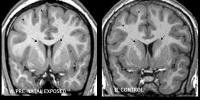
The brain image at left is from a subject exposed to alcohol, cigarettes, cocaine and marijuana in utero, while the image at right is from a same-age, same-sex control with none of these exposures. Note that the cortical gray matter appears thinner in the exposed brain than in the control (black arrowheads). In addition, the subcortical gray matter appears fuller and more robust in the control brain (see arrows near top of image) than in the exposed brain. Credit: Courtesy Christopher Watson and Michael Rivkin, MD, Children's Hospital Boston Although behavioral studies clearly indicate that exposure to drugs, alcohol and tobacco in utero is bad for a baby’s developing brain, specific anatomic brain effects have been hard to tease out in humans. Often users don’t limit themselves to one substance, and demographic factors like poverty can also influence brain development.
Now, an NIH-funded study using magnetic resonance imaging (MRI) brain scans, led by Children’s Hospital Boston neurologist Michael Rivkin, MD, suggests that prenatal exposure to cocaine, alcohol, marijuana or tobacco (alone or in combination) may have effects on brain structure that persist into early adolescence. The findings, published in the April issue of Pediatrics, are of public health significance, the researchers say, since it’s estimated that more than 1 million babies born annually in the United States have been exposed to at least one of these agents in utero.
Researchers at Children’s and Boston Medical Center employed volumetric MRI imaging to study the brain structure of 35 young adolescents prenatally exposed to cocaine, marijuana, alcohol or tobacco. The children, who averaged 12 years old at the time of imaging, were part of part of an historic cohort of children assembled by Deborah Frank, MD at Boston Medical Center and followed there since birth. Prenatal exposures were confirmed by a combination of maternal history, urine testing of the mother or urine or meconium (stool) testing of the infants at birth.
“We found that reductions in cortical gray matter and total brain volumes were associated with prenatal exposure to cocaine, alcohol or cigarettes,” says Rivkin, who is first author on the study. “Importantly, although volume reductions were associated with each of these three prenatal exposures, they were not associated with any one of these substances alone after controlling for other exposures.”
Notably, the effects were found to be additive – the more substances a child was exposed to in utero, the greater the reduction in brain volume.
Rivkin notes that the study is also the first to document joint long-term neuroanatomic effects on the brain of prenatal cocaine, cigarette and alcohol exposures. Moreover, while previous studies have documented brain effects of prenatal alcohol exposure, these studies were mostly limited to children with fetal alcohol syndrome, a diagnosis that was excluded in the current study.
Although investigators initially set out to study cocaine exposure, they were struck by the finding of brain effects of prenatal tobacco exposure. “Approximately 20 percent of women who smoke continue to smoke during pregnancy,” Rivkin says. “From the vantage point of preventive health care, it is important to determine the consequences on brain structure of prenatal exposure to cigarettes, alone and in combination with other substances.”
Rivkin emphasizes that the number of children studied was too small to find statistically significant effects of single substances after controlling for exposure to other agents. The study was also too small to consider the effects of different levels of exposure. But the overall results are highly suggestive. “We’re hopeful to be able to study the whole sample of 150 children followed at Boston Medical Center, which will permit such determinations,” Rivkin says.
Both investigators concur that health care providers should offer pregnant women comprehensive care to help them reduce use of all psychoactive substances. Public health campaigns should not ignore the risks of some substances while focusing on others, as it may well be that the greater the number of total prenatal exposures, the higher the chance there will be adverse and lasting consequences for the developing brain.
Source : Children's Hospital Boston
 Print Article
Print Article Mail to a Friend
Mail to a Friend
